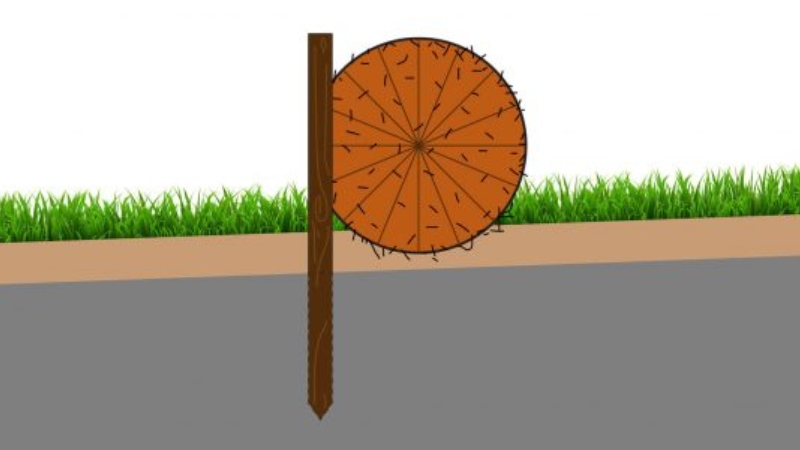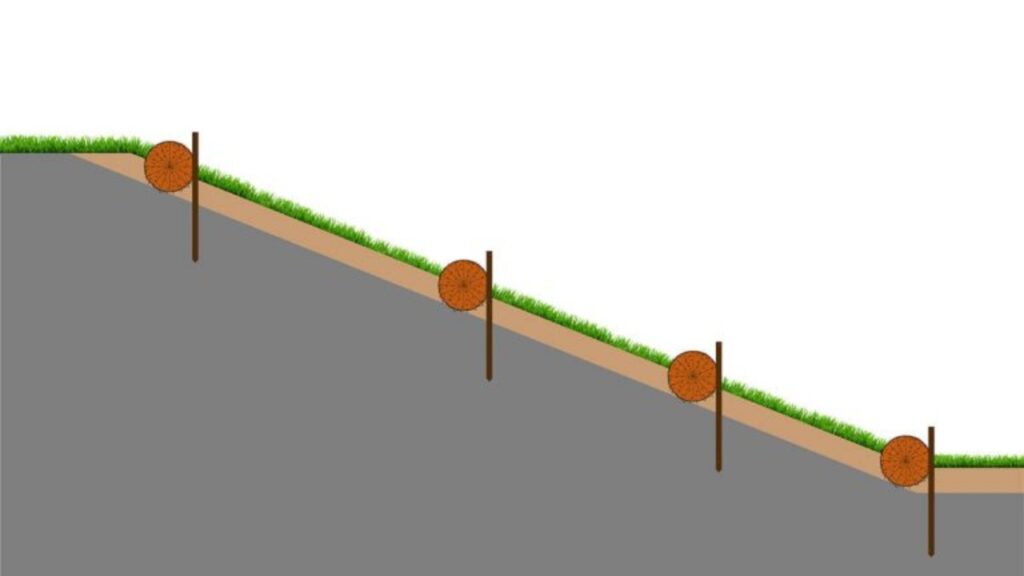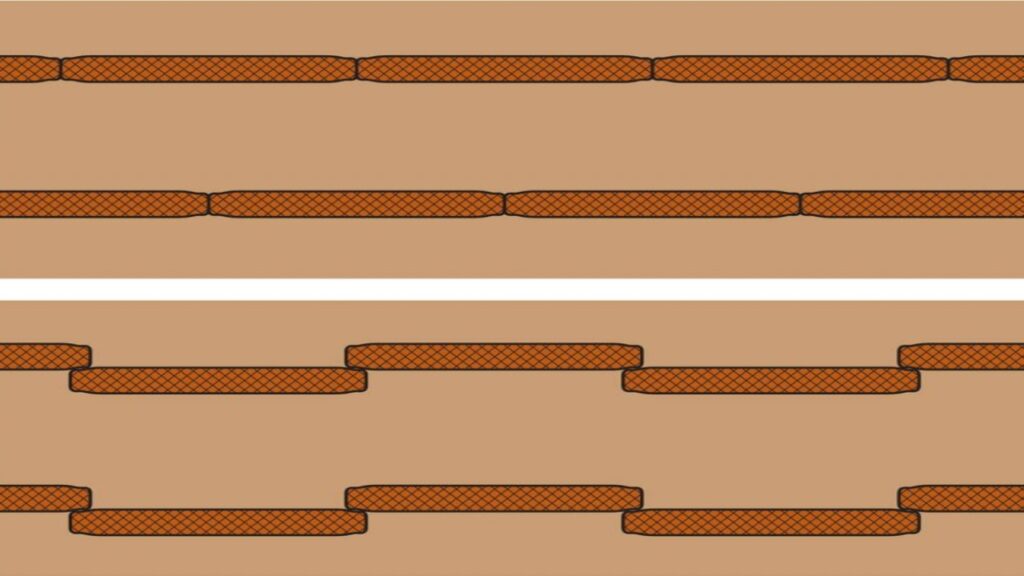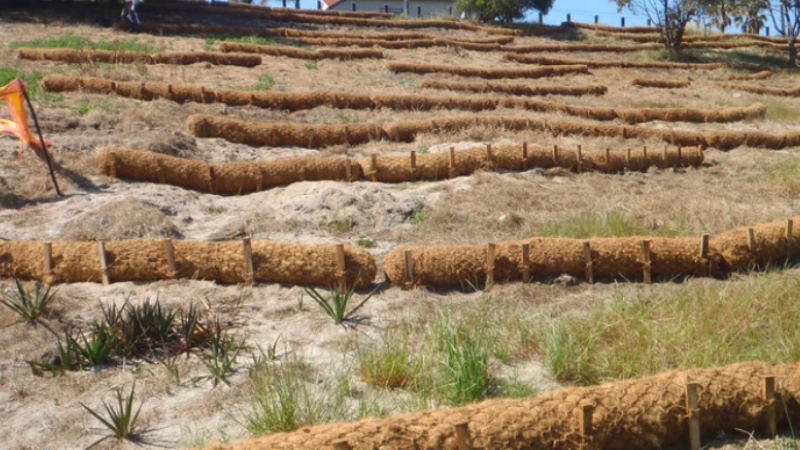Have you ever wondered what is the correct way to install coir logs?
Coir logs have a number of applications they are well suited for but are often installed incorrectly resulting in a failure of some type.
The most common applications are:
- Check structures in easements or waterways; and
- Most commonly in batter erosion control.
Often we see the logs looking very pretty on the surface, on top of the topsoil or even on top of the blown mulch. While this is visually appealing, in most cases the logs themselves are doing very little to protect the topsoil from being washed away in rain events.
1. Check Structures in Easements or Waterways
When installing coir logs in easements or waterways the primary function of the log is to slow the flow of water in the drain. This reduces the risk of water lifting the topsoil and carrying it along.
When coir logs are used in this application, we need the water to do one of the following; (i) pass through the coir log, or (ii) pass over the coir log. The coir logs should be installed in such a way that the water does not pass below the log as this will begin to erode the soil.
Installation in Easements or waterways
For seeded drains:
- Ensure your surface is trimmed to site specifications, is smooth and free from obstructions.
- Coir logs are to be installed before hydro mulching, to ensure that at least 1/3 of the coir log is below the top surface level.
- Install logs across the drain, spaced 5m-15m apart depending on the potential water flow velocity.
- Always peg the coir logs on the lower side of the log, making sure the peg goes through the outer mesh of the log.
- Use 450mm x 50mm x 25mm timber pegs for 200mm coir logs, or 600mm x 50mm x 25mm timber pegs for 300mm coir logs. The pegs should be driven an equivalent length into the ground as what is above ground.
- Hydromulch the drain once the logs are all installed.
For turfed drains:
- Ensure your surface is trimmed to site specifications, is smooth and free from obstructions.
- Coir logs are to be installed on top of the topsoil prior to turfing.
- Install logs across the drain, spaced 5m-15m apart depending on the potential water flow velocity.
- Always peg the coir logs on the lower side of the log, making sure the peg goes through the outer mesh of the log.
- Use 450mm x 50mm x 25mm timber pegs for 200mm coir logs, or 600mm x 50mm x 25mm timber pegs for 300mm coir logs. The pegs should be driven an equivalent length into the ground as what is above ground.
- Once logs are installed, lay the turf up to the logs as per image (Figure 1) below.

2. Topsoil Containment Structures (Batter Erosion Control)
This is by far the most common application for coir logs, and unfortunately where we see the most install errors. In this application, the coir log is often only a visual product and not used to effectively reinforce the soil on which it is placed.
The purpose of the coir log in this application is to reduce the risk of the topsoil, mulch and plants being washed out in a large rain event.
Installation in Batters, Slopes and Embankments
Coir logs are best installed directly onto the profiled slope prior to any topsoil, mulch or planting being done. This ensures they will sit in rather than on the topsoil, preventing it from being washed out from underneath the log. (see figure 2 below)

a) Ensure batter is profiled to the required gradient, is smooth and free from obstructions.
b) For topsoil of up to 150mm, use 200mm coir logs. For topsoil deeper up to 250mm, use 300mm coir logs.
c) Install the coir logs across the face of the slope, starting from the lowest row and working up. Ensure the logs are butted right up to the one next in line. Better still, if they could be overlapped by 150mm (see figure 3 below) this will ensure soil will not be washed between the logs.
d) Peg the coir logs to the batter, using 450mm x 50mm x 25mm timber pegs for 200mm coir logs, or 600mm x 50mm x 25mm timber pegs for 300mm coir logs. The pegs should be driven an equivalent length into the ground as what is above ground.
e) Always drive the pegs through the coir log, not in the centre of the log, but towards the lower edge of the log to ensure a greater part of the log is taking the load of soil reinforcement. (pegs should not be driven either side of the log, as in high rainfall events the logs can be lifted over the pegs)
f) Use a minimum of 3 pegs per log, 1 on each edge and 1 in the centre for slopes up to 3:1. For steeper gradients than this, use minimum of 4 pegs.
g) Once the bottom row of logs is complete, install the next row 2.5m above bottom row for batters at less than 3:1. For batters of up to 2:1, work on 2m spacing between rows, and 1:1 gradient will need maximum spacing of 1.5m. (for 1:1 batters, it is recommended you speak to a qualified engineer to determine the best method of stabilisation for your application)
h) Once coir logs have been pegged in properly, you can proceed to backfill the topsoil in behind the rows of logs.
i) Once the topsoil and mulch has been applied, the coir logs should be almost buried.
j) For embankments that have been hydro mulched, it is recommended to use a coir mesh blanket to protect against wind erosion. The coir mesh can be installed vertically down the slope over the top of the coir logs and pinned at regular intervals.
Why do I use a temporary erosion control blanket as well as coir logs? Very valid question!
The Coir Log is a retaining structure designed to protect against water erosion. The blankets are designed to control wind erosion. They also hold moisture ensuring optimum soil conditions for tube stock or seed growth.
For any site-specific recommendations, please feel free to reach out at Technical@polyfabrics.com.au or call 1300 287 484


